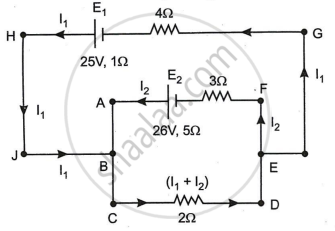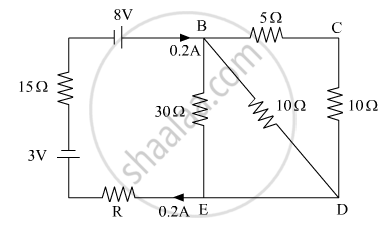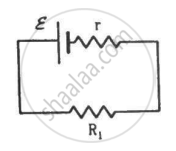Advertisements
Advertisements
Question
In the circuit shown in Figure below, E1 and E2 are batteries having emfs of 25V and 26V. They have an internal resistance of 1 Ω and 5 Ω respectively. Applying Kirchhoff’s laws of electrical networks, calculate the currents I1 and I2.

Solution
Applying Kirchhoff's voltage law to loop ABCDEF, we get
2(I1 + I2) + 3I2 - 26 + 5I2 = 0
or 2I1 + 2I2 + 3I2 + 5I2 = 26
or I1 + 5I2 = 13 ...(i)
Now, applying Kirchhoff’s voltage law to loop HJBCDEG.
2(I1 + I2) + 4I1 + I1 - 25 = 0
or 2I1 + 2I2 + 5I1 = 25
or 7I1 + 2I2 = 25 ...(ii)
Equation (i) × 2 - equation (ii) × 5
2I1 + 10I2 = 26
35I1 + 10I2 = 125
- - -
- 33I1 = - 99
I1 = 3
From equation (i)
3 + 5I2 = 13
or I2 = 2
Hence I1 = 3 A
I2 = 2 A.
APPEARS IN
RELATED QUESTIONS
Calculate the value of the resistance R in the circuit shown in the figure so that the current in the circuit is 0.2 A. What would b the potential difference between points B and E?

Two unequal resistances, R1 and R2, are connected across two identical batteries of emf ε and internal resistance r (see the figure). Can the thermal energies developed in R1 and R2 be equal in a given time? If yes, what will be the condition?


State Kirchhoff ’s voltage rule.
A copper wire of 10-6 m2 area of cross-section, carries a current of 2 A. If the number of electrons per cubic meter is 8 × 1028, calculate the current density and average drift velocity.
In a potentiometer arrangement, a cell of emf 1.25 V gives a balance point at 35 cm length of the wire. If the cell is replaced by another cell and the balance point shifts to 63 cm, what is the emf of the second cell?
Kirchhoff’s second law is a consequence of law of conservation of ______.
The Kirchhoff's second law (ΣiR = ΣE), where the symbols have their usual meanings, is based on ______.
Kirchhoff s second law is based on the law of conservation of ______
The circuit in figure shows two cells connected in opposition to each other. Cell E1 is of emf 6V and internal resistance 2Ω; the cell E2 is of emf 4V and internal resistance 8Ω. Find the potential difference between the points A and B.
A 6-volt battery is connected to the terminals of a three-metre-long wire of uniform thickness and resistance of 100 ohms. The difference of potential between two points on the wire separated by a distance of 50 cm will be ______.
